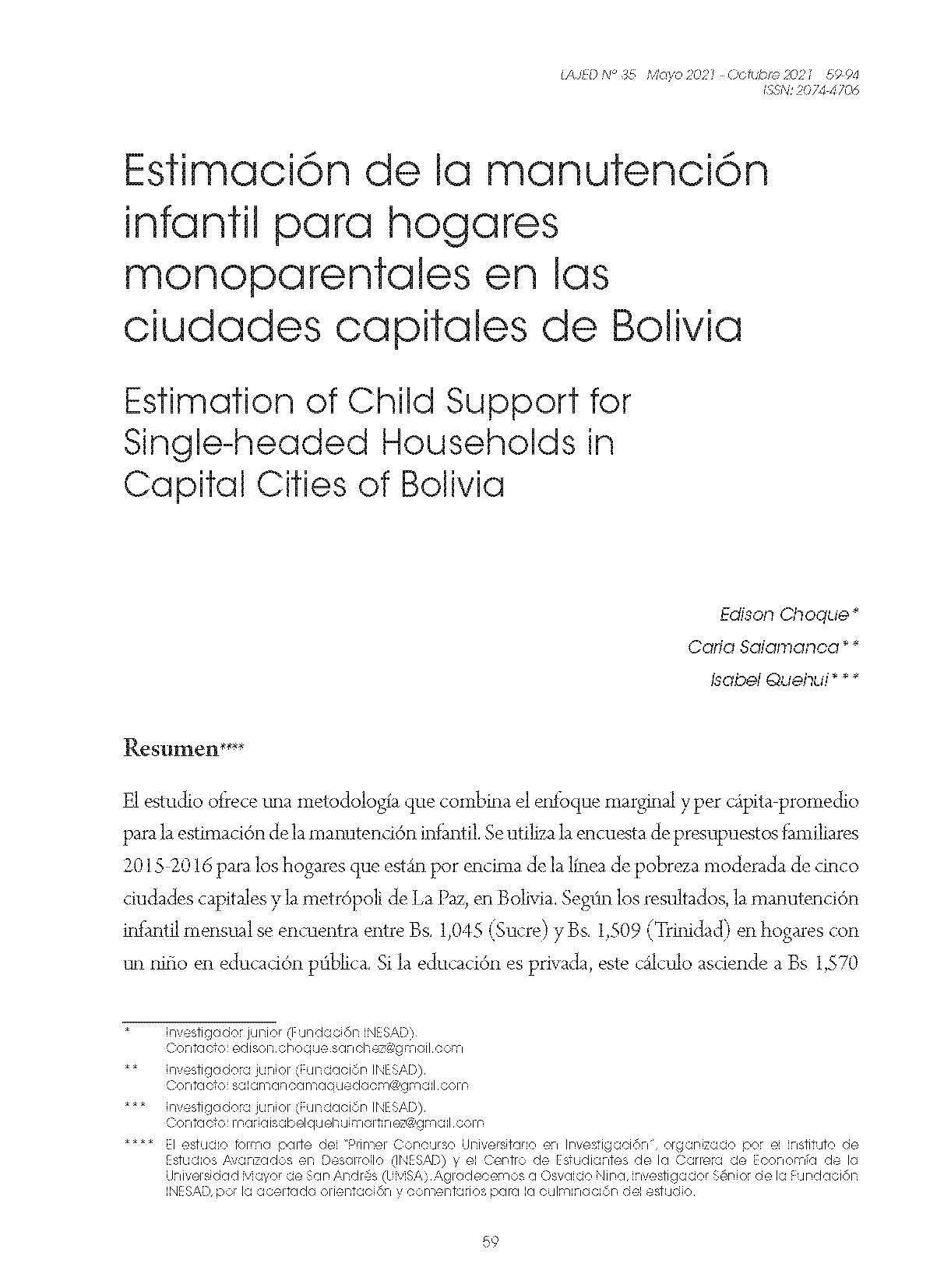Estimation of Child Support for Single-headed Households in Capital Cities of Bolivia
DOI:
https://doi.org/10.35319/lajed.202135439Keywords:
Matching, child support, single-headed household, common rangeAbstract
The study offers a methodology that combines the marginal and per capita-average approach for estimating child support. The 2015-2016 family budget survey is used for households above the moderate poverty line in 5 capital cities and the metropolis of La Paz, in Bolivia. According to the results, monthly child support lies between Bs. 1,045 (Sucre) and Bs. 1,509 (Trinidad) in households with a child enrolled in public education. If education is private, this calculation rises to Bs. 1,570 (La Paz-metropolis) and Bs. 1,959 (Trinidad). In the metropolis of La Paz, child support represents 67% and 87% of the national minimum wage when children study in public and private schools respectively. It is evident that these percentages are higher than the minimum of 20% established by the Family and Family Process Code (Law Nº 603, 2014).
Downloads
References
Alonzo, H. y Mancero, X. (2011). Escalas de equivalencia en los países de América Latina. Comisión Económica para América Latina. https://repositorio.cepal.org/handle/11362/4777.
Becker, G. S. (1993). A Treatise on the Family, primer edition. Harvard university press (eds.), The Demand for Children (pp. 135-155). https://books.google.com.bo.
Betson, D. (2006). Parental expenditures on children: Rothbarth estimates. A report prepared for Policy Studies, Inc., for the State of Oregon. http://www.guidelineeconomics.com/files/Betson2010CaliforniaReport.pdf.
Blackwell, I, King, G. y Porro, G. (2009). CEM: Coarsened Exact Matching in Stata. The Stata Journal, 9, 524-546. https://doi.org/10.1177/1536867X0900900402
Bolivia. Ley N°603. Código de las familias y del proceso familiar. Estado Plurinacional de Bolivia, 19 de noviembre de 2014. La Paz, Bolivia.
Calder, G. (2018). Social justice, single parents and their children. En R. Nieuwenhuis y C. Maldonado (eds.), The triple bind of single-parent families (pp. 421-435). https://books.google.com.bo.
Chiappori, P.A. (1988). Rational household labor supply. Econometrica, 56(1), 63-90. https://doi.org/10.2307/1911842
---------- (1992). Collective labor supply and welfare. Journal of Political Economy, 100(3), 437-467. https://www.journals.uchicago.edu/doi/pdf/10.1086/261825
Comanor, W., Sarro, M., y Rogers, R. (2015). The Monetary Cost of Raising Children. En James Langenfeld (ed.), Economic and Legal Issues in Competition, Intellectual Property, Bankruptcy, and the Cost of Raising Children, Research in Law and Economics, Volume 27, (pp. 209-251). Emerald Group Publishing Limited. https://ideas.repec.org/h/eme/rlwezz/s0193-589520150000027008.html
Deaton, A. y Muellbauer, J. (1986). On measuring child costs: With applications to poor countries. Journal of Political Economy, 94(4), 720-744. http://dx.doi.org/10.1086/261405
Deaton, A., Ruiz, J. y Thomas, D. (1989). The influence of household composition on household expenditure patterns: theory and Spanish evidence. Journal of political economy, 97(1), 179-200. http://www.jstor.org/stable/1831059
Echeverría, L., Menon, M., Perali, F. y Berges, M. (2019). Intra-household inequality and child welfare in Argentina (Documento de Trabajo Nº 241). Buenos Aires, Argentina: Centro de Estudios Distributivos, Laborales y Sociales. http://sedici.unlp.edu.ar/handle/10915/72144
Ellman, I. (2004). Fudging failure: The economic analysis used to construct child support guidelines. Universidad de Chicago. Legal Forum, 2004(1), 167-224. https://papers.ssrn.com/sol3/papers.cfm?abstract_id=519302
Gertler, P., Martínez, S., Premand, P., Rawlings, L. y Vermeersch, C. (2017). La evaluación de impacto en la práctica (2a ed.). The World Bank. https://elibrary.worldbank.org/doi/abs/10.1596/978-1-4648-0888-3
Gronau, R. (1991). The intrafamily allocation of goods-how to separate the adult from the child. Journal of Labor Economics, 9(3), 207-235. https://www.journals.uchicago.edu/doi/abs/10.1086/298266.
Heckman, J. (2017). The Heckman Equation. Heckman: The Economics of Human Potential. http://www.Heckmanequation.org/heckmanequation.
Heinrich, C., Mafloli, A. y Vázquez, G. (2010). A primer for applying propensity-score matching. Inter-American Development Bank (eds.), How to Implement Propensity-Score matching (PSM) (pp. 22-28). https://publications.iadb.org/publications/english/document/A-Primer-for-Applying-Propensity-Score-Matching.pdf.
Instituto Nacional de Estadística del Estado Plurinacional de Bolivia (2019). Encuesta de presupuestos familiares 2015-2016. La Paz, Bolivia: INE.
---------- (2020). Estadísticas sociales. La Paz, Bolivia: INE. https://www.ine.gob.bo/
Lino, M., Kuczynski, K., Rodríguez, N. y Schap, T. (2017). Expenditures on Children by Families, 2015. Miscellaneous Publication Nº 1528-2015. U.S. Department of Agriculture. Center for Nutrition Policy and Promotion. https://www.youngwilliams.com/expenditures-children-families-2015-revised
Nicholson, J. L. (1976). Appraisal of different methods of estimating equivalence scales and their results. Review of Income and Wealth, 22(1), 1-11. https://doi.org/10.1111/j.1475-4991.1976.tb01138.x
Organización de Naciones Unidas Mujeres (ONU mujeres). (2020). El progreso de las mujeres en el mundo 2019-2020: Familias en un mundo cambiante. https://www.unwomen.org/en/digital-library/progress-of-the-worlds-women
Pollak, R. y Wales, T. (1981). Demographic variables in demand analysis. Econometrica: Journal of the Econometric Society, 49(6), 1533-1551. https://doi.org/10.2307/1911416
Rosenbaum, P. y Rubin, D. (1983). The central role of the propensity score in observational studies for causal effects. Biometrika, 70(1), 41-55. https://doi.org/10.1093/biomet/70.1.41






